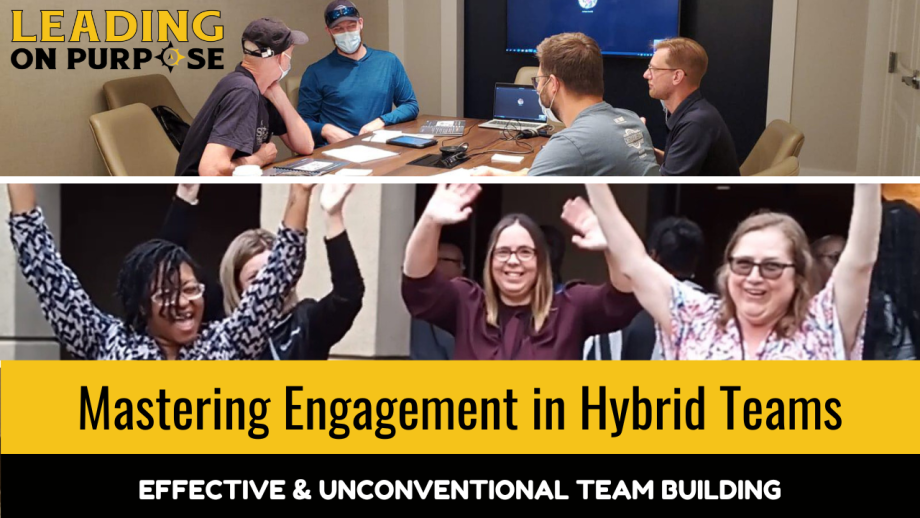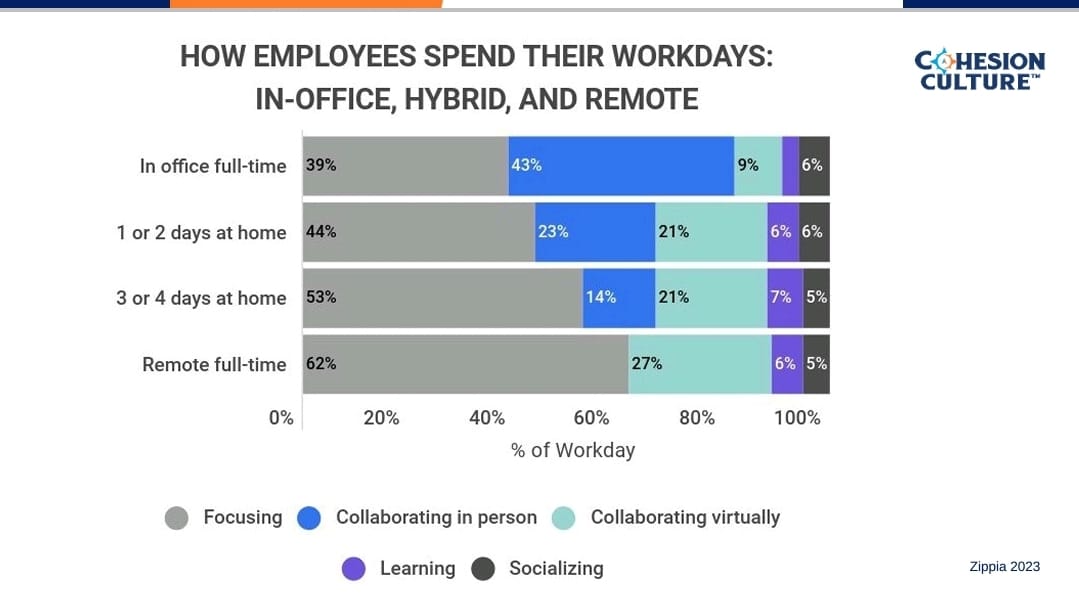
Mastering Engagement in Hybrid Teams
Does this sound familiar?
You call a team meeting. Your hybrid team of 15 employees consists of 10 in-person employees with 5 working remotely. The 10 in-person employees trickle into the conference room, exchanging greetings and having side conversations. Then, you start the Zoom call, bringing in the remote workers.
The in-person employees bring in one laptop, perhaps with a large TV broadcasting the remote employees, with one camera. There's a whiteboard setup for in-person employees to brainstorm ideas on. You also have one laptop microphone broadcasting the sound to remote workers.
But are your remote employees truly having the same experience as their in-person counterparts?
No, but can you identify all the ways the virtual experience is lacking?
- Greetings and side conversations. While in-person employees enjoy water cooler chat, the remote employees are dialed in with no greeting, no friendly banter with their co-workers. Just a cold open.
- Remote employees can't see much. The single camera is too far away, providing a grainy, pixelated image. They struggle to identify speakers or read the whiteboard.
- The microphone is 10 feet away from the speaker, causing sound interruptions. Again, they can't identify speakers, and they lack opportunities to contribute throughout the meeting.
Final question, do you believe these remote workers stay engaged throughout the meeting when they can't see or hear, or do they likely zone out?
If your organization conducts hybrid meetings in this manner, the good news is you can update your practices to re-engage these virtual workers.
This chart shows that remote only employees collaborate less than their in-person counterparts. While in-office full-time employees spend 52% of their workdays collaborating, whether in-person or virtually, their fully remote counterparts collaborate only 27% of the time. That's almost 50% less time spent on collaboration. This can and should be remedied through deliberate actions by leadership to foster a collaborative environment for all employees. (Zippia 2023)
The New Power Struggle
In the history of business, there has always been a power struggle, the us and them, between the sales team and operations. Think about the sales team on The Office believing they deserve raises over the rest of the staff because they're the ones bringing in revenue. (When obviously all employees contribute to sales, just not as directly.)
Since the increase of remote workers there has now been a shift with the power struggle becoming between the in-person employees versus remote.
Some people believe they are superior because they HAVE to work in the office, thinking their job is more important.
Others believe their job is more crucial because it can be done remotely, without the need to be in the office every single day.
In truth, it comes down to the work—whether it can be done in-person or remotely. And it's about the employees, their lifestyles, working styles, and productivity levels—whether they prefer remote work or an office environment.
Be Intentional With Your Hybrid Team
There has to be intentionality with bringing in remote people, especially with a hybrid team. Leaders must be thoughtful of the virtual employees experience in every aspect of business, from their daily tasks to meetings to office parties.
It's easy to walk by somebody and begin a conversation that turns into a productive brainstorming session. In a remote scenario, most engagement is very scheduled. You have a scheduled video call or send an email or Slack message that the recipient reads when they get a chance. There's no easy back and forth or water cooler talk.
My rule of thumb comes from the T.E.A.M. method:
- Target: What is/are the purpose/ goals of the meeting?
- Engagement: What will the audio/visual and seating experience of each person be like?
- Affirmations: Who is speaking positively about their coworkers' contributions?
- Manage: Who is to be included in this gathering, functional work team, project team, clients/vendors, etc.?
For the engagement part of the T.E.A.M. method, let's refer back to the example from the beginning of this newsletter. That hybrid team of 15 with 10 employees meeting in-person with 5 remote employees joining from home. A better way to hold this meeting would be for every in-person employee to bring their laptop into the meeting. They join the video call just like the remote workers. But only one person joins with audio.
Now you have a great scenario because the people at home get to see faces and names of all the team members. I like to incorporate a bluetooth speaker that has higher volume potential. Another great addition is an external web cam that is closer to a whiteboard for example.
Now, everyone experiences the meeting the same way, whether in-person or remote.
Connection before content. Begin the meeting with ice breakers or a huddle. Get the remote employees just as engaged and dialed in as the in-person employees. Engage these virtual employees before beginning the meeting rather than Zoom calling them in and starting the meeting right away.
Now, let's address the feedback loop. When employees respond during the meeting, the feedback is written on a whiteboard. Can the remote employees actually read what is on the whiteboard? This is an important part of the meeting communication and needs to be available to all.
Can somebody sitting in the meeting replicate on a digital whiteboard so remote employees aren't straining to see what's actually happening? Think through the relay piece because you'll have higher interest among all employees and keep virtual workers from zoning out. Good camera and sound quality is also important to keep people engaged.
We have a 3-step program for managers of remote teams. This program takes place on Zoom where we teach leaders the elements that you naturally would do in-person. You have to re-train your brain to think through every step to provide the best experience for in-person and remote team members. We also demonstrate how to use the technology in your favor for good collaboration, good brainstorming, and good communication
Make the remote folks a priority and not an afterthought.
Some organizations are entirely remote, some entirely in-person, and more and more are becoming hybrid with a combination of both in-person and remote employees. This is the world that we are in and it's up to leaders to update their practices to give both kinds of employees the best experience.
The people who are remote have a higher probability of changing careers and jumping from job to job. However, if you want to maintain your culture, you have to bring them in with purpose and with meaningful work. Mastering engagement in hybrid teams leads to greater productivity, increased creativity, and higher talent retention.
For more on this topic, check out these blog posts:










